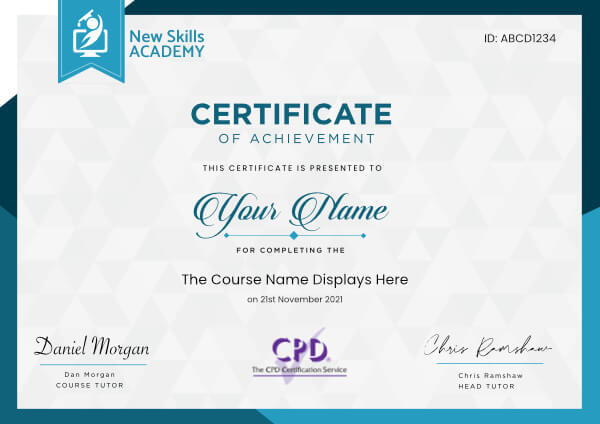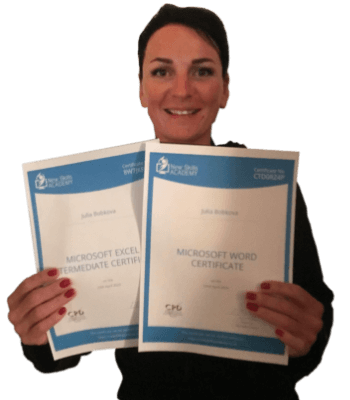International Garden Design and Maintenance Diploma
International Garden Design and Maintenance Diploma Course
Do you have a love for nurturing the great outdoors, are you a green-fingered gardener? Have you ever thought about obtaining a garden design diploma? With this course you could become a qualified gardener just like thousands of other people have with our courses. For a one-off fee, you can study online and complete the diploma in about 15 hours.
The comprehensive syllabus is supported by experienced tutors who are there to help you through email. With 29 modules to cover, you can learn everything from ‘how to build a pond’ to ‘plant selection and care’. Your qualification will be recognised and can be checked for validity by all of your future clients too! Take a step in the right direction and get your Garden Design Diploma today.
This course includes
24/7 Student Support
End of course certification
Lifetime access to your course
Compatible with modern devices
- Soil type, soil evaluation & soil improvement: learn about the different types of natural soil and additional plant mixers which can be used to stimulate plant growth.
- Garden planning & preparation: Understand the importance of initial planning on paper, before beginning the practical aspects of gardening
- Plant planning & purchase tips: Determine plant types and their uses, discover plant purchasing techniques.
- Maintenance-Soil Nourishment & Watering: Learn the different materials essential for the nourishment of soil to facilitate growing and maintenance of healthy plants.
- The importance of the initial consultation, ongoing discussions, clarity and onsite analysis.
- The necessity of site surveying and garden concept plans to aid the decision making process and avoid potential mishaps.
- The basic elements of good garden design, including the plant options, hardscapes, texture and color elements.
- How to gain knowledge around garden project management, garden coaching and maintenance planning for the completed project.
- The importance of gathering inspiration daily from all avenues of your life, nature, other gardens, books, online and your creative inspiration
- About how creating a garden design mood board assists both the owner and garden designer in creating a visual effect of the ideas, colors, plants and overall theme that is preferred
- About implementing your design choice
- About the option of a virtual mood board created from an array of images
- About the materials and areas of measurements required for surveying a site for garden design
- About the various scales used in recording site measurements on survey maps
- About the correct photographic recordings and survey map drawing requirements
- What site appraisal records and site survey check-lists you need
- The benefits of project planning regardless of the size of project.
- The importance of creating timelines, chronological action step lists and available resources
- About developing preliminary plans and baseline plans when planning a garden project
- The importance of being flexible, documenting all actions and transactions and keeping the lines of communication open
- About the use of forced perspective
- Ways to incorporate and create optical illusion methods to enhance small garden spaces so they appear larger
- How to effectively use the space available to you
- About the techniques available to you to create more space when designing a garden plan
- How time spent with creative experimentation on paper can result in saving a lot of timely and costly delays and allow for the optimal garden creation for each space
- How to draw a garden plan which offers beauty and practicality once you have carried out a site survey and consultation
- How to create a scale for your garden plan that allows ease of following and minimize mistakes
- How to create a graphic from your garden plan to show best visual representation for the proposed changes and design options
- The different considerations before deciding on which garden surface materials to choose for each landscape for effective style & functionality.
- About the different hard landscaping options which can be used for varying garden requirements and preferences from solid garden flooring options like stone and concrete to softer, uneven options such as glass beadings or pebbles.
- How to determine different types of hard landscaping combinations such as wood and metal, gravel and stone or glass beadings, which can be achieved to create unique, attractive garden flooring surfaces.
- About the use of hard landscaping materials that are used to turn dull spaces into stunning visual displays and create functional but attractive garden areas.
- The composition of the various soil types including their textures and unique components
- The advantages and disadvantages of the different types of soil and what can be done to enhance each for increased fertility
- The types of plants that are best suited to each soil type: sandy, chalky, clay, peat, silt and loam
- The secrets of creating great soil by use of organic, natural materials.
- The advantages of planting native species to enhance your garden and surrounding wildlife species.
- How to make best use of space constraints and other factors to adhere to when planning the spatial aspects of plant-life.
- About color themes and the color wheel so that the garden plants, shrubs and trees chosen complement the existing background and client preferences.
- About the effect of sunlight and climate features in relation to plant selection
- Understand plant reproductive systems: Asexual and sexual reproduction, plus a little plant physiology.
- Receive a brief introduction to plant classification for a beginning to what plants to use.
- Learn what plants work well in different gardens and the importance of matching certain plants together.
- Learn about exotic and tropical plants, the care they need and how to grow them in temperate climates.
- How to Identify High Maintenance Areas in an Existing Garden
- The Different Tpes of Low Maintenance Gardens
- How to Use Gravel, Soil, and Turf to Make the Garden Maintenance Lower
- About Planting Few Varieties, but More in Number
- Why creating a garden with plants that are maintainable is important
- Why edible plants are sustainable
- About Saving Water for Conservation
- About Reusing and Recycling Materials in the Garden
- How to reduce maintenance if it is getting out of control
- About pruning and deadheading for appropriate care of plants
- How fertilizer enhances the soil
- About winterization in a temperate climate is an essential part of owning a garden
- What equipment you will need to run a garden design & maintenance service
- How to choose the right tools for each job
- What each piece of equipment is capable of
- About racks & stakes for vine plants
- What garden pests are
- Natural versus Chemical Pesticides
- About Integrated Pest Management
- About Coming up with Multiple Treatment Plans
- About adding container plants to keep the plants owners love without possible difficulties
- How changing irrigation and watering systems can make a difficult garden easier to manage
- About adding new plants with an eye towards low maintenance or new landscaping for easier gardens
- How sometime starting over is the best option
- What to plant
- How to plant vegetable and herb gardens
- How to fertilize the garden
- About canning
- About tailoring your services to meet the needs of groups of customers
- How to build a website presence
- How to price your service
- Why customer service is essential
- About website business marketing
- About marketing and social media for a bricks and mortar company
- Why networking is still important
- About advertising costs
- Health and Safety Laws including the Policy Statement
- Responsibilities of an employer, employee and safety officer
- Risks involved in gardening
- Employee Training requirements
- The different types of insurance required
- About income business tax structure
- About record keeping software
- Hiring an accountant
- Benefits of raised beds
- Materials to use for raised beds
- Ideal dimensions for raised beds
- Step by step directions of how to make a raised bed
- What materials to use for a patio
- Things to consider while planning and laying a patio
- What is an ideal size for a patio
- Step by step guide
- How to plan a deck
- How decide on the ideal placement for decking
- What materials and tools you will need
- Step by step guide to building decking
- What factors to consider while deciding upon a fence type
- The types of fences available and where to use them
- How to calculate the amount of material you will need to construct a fence
- How to put up a fence with vinyl coated welded wire fence with T posts
- About choosing the right grass or turf for the lawn
- How to prepare the soil for turf
- How to take care of turn to establish a lawn
- A step by step guide to laying turf
- Why there is a need for artificial turf
- The types of turf available
- The materials and tools you will need
- Step by step guide to laying artificial grass
- About choosing the right site for a pond
- How to select the correct lining
- About the materials and tools needed to build a pond
- Step by step instructions to build a basic pond
 ID: YDFT67YHJ
ID: YDFT67YHJ
of achievement
This certificate is presented to
Your Name

For completing the
International Garden Design and Maintenance Diploma
on 21st November 2024
Selena Hurford
Selena Hurford
Course Tutor

Daniel Morgan
Daniel Morgan
Head of Academy

Anyone who has an interest in learning more about this subject matter is encouraged to take the course. There are no entry requirements to take the course.
The course is broken down into 29 individual modules. Each module takes between 20 and 90 minutes on average to study. Although you are free to spend as much or as little time as you feel necessary on each module, simply log in and out of the course at your convenience.
You can study the course any time you like. Simply log in and out of the web based course as often as you require. The course is compatible with all computers, tablet devices and smart phones so you can even study while on the move!
Once you have completed all 29 modules there is a multiple choice test. The questions will be on a range of topics found within the 29 modules. The test, like the course, is online and can be taken a time and location of your choosing.
The pass mark for the test is 70%.
If you don’t pass the test first time you will get further opportunities to take the test again after extra study. There are no limits to the number of times you can take the test. All test retakes are included within the price of the course.
Once you have completed your test you can log in to your account and download/print your certificate any time you need it. If you would prefer us to post you a certificate to a UK address, there will be an admin charge of £10 (certificates sent internationally may cost more).
You can either use your Visa, MasterCard, American Express, Solo cards or PayPal account to pay for the online course. Our site uses the latest SSL encryption to ensure your safety. All payments are handled securely by PayPal.
You can begin the course immediately after your payment has been received. You will create your login details during the checkout process. We will also send you an email confirming your login details.
We estimate that the course will take about 15 hours hours to complete in total, plus an additional 30 minutes for the end of course test.
Once you have been awarded your certificate it is valid for life. The certificate does not expire or need renewing.
 It was very good experience. I took very necessary and valid information about garden design. Every module was very interesting an pleasant. Matilda Pashi
It was very good experience. I took very necessary and valid information about garden design. Every module was very interesting an pleasant. Matilda Pashi
International Garden Design and Maintenance Diploma Course
Do you have a love for nurturing the great outdoors, are you a green-fingered gardener? Have you ever thought about obtaining a garden design diploma? With this course you could become a qualified gardener just like thousands of other people have with our courses. For a one-off fee, you can study online and complete the diploma in about 15 hours.
The comprehensive syllabus is supported by experienced tutors who are there to help you through email. With 29 modules to cover, you can learn everything from ‘how to build a pond’ to ‘plant selection and care’. Your qualification will be recognised and can be checked for validity by all of your future clients too! Take a step in the right direction and get your Garden Design Diploma today.
This course includes
24/7 Student Support
End of course certification
Lifetime access to your course
Compatible with modern devices
- Soil type, soil evaluation & soil improvement: learn about the different types of natural soil and additional plant mixers which can be used to stimulate plant growth.
- Garden planning & preparation: Understand the importance of initial planning on paper, before beginning the practical aspects of gardening
- Plant planning & purchase tips: Determine plant types and their uses, discover plant purchasing techniques.
- Maintenance-Soil Nourishment & Watering: Learn the different materials essential for the nourishment of soil to facilitate growing and maintenance of healthy plants.
- The importance of the initial consultation, ongoing discussions, clarity and onsite analysis.
- The necessity of site surveying and garden concept plans to aid the decision making process and avoid potential mishaps.
- The basic elements of good garden design, including the plant options, hardscapes, texture and color elements.
- How to gain knowledge around garden project management, garden coaching and maintenance planning for the completed project.
- The importance of gathering inspiration daily from all avenues of your life, nature, other gardens, books, online and your creative inspiration
- About how creating a garden design mood board assists both the owner and garden designer in creating a visual effect of the ideas, colors, plants and overall theme that is preferred
- About implementing your design choice
- About the option of a virtual mood board created from an array of images
- About the materials and areas of measurements required for surveying a site for garden design
- About the various scales used in recording site measurements on survey maps
- About the correct photographic recordings and survey map drawing requirements
- What site appraisal records and site survey check-lists you need
- The benefits of project planning regardless of the size of project.
- The importance of creating timelines, chronological action step lists and available resources
- About developing preliminary plans and baseline plans when planning a garden project
- The importance of being flexible, documenting all actions and transactions and keeping the lines of communication open
- About the use of forced perspective
- Ways to incorporate and create optical illusion methods to enhance small garden spaces so they appear larger
- How to effectively use the space available to you
- About the techniques available to you to create more space when designing a garden plan
- How time spent with creative experimentation on paper can result in saving a lot of timely and costly delays and allow for the optimal garden creation for each space
- How to draw a garden plan which offers beauty and practicality once you have carried out a site survey and consultation
- How to create a scale for your garden plan that allows ease of following and minimize mistakes
- How to create a graphic from your garden plan to show best visual representation for the proposed changes and design options
- The different considerations before deciding on which garden surface materials to choose for each landscape for effective style & functionality.
- About the different hard landscaping options which can be used for varying garden requirements and preferences from solid garden flooring options like stone and concrete to softer, uneven options such as glass beadings or pebbles.
- How to determine different types of hard landscaping combinations such as wood and metal, gravel and stone or glass beadings, which can be achieved to create unique, attractive garden flooring surfaces.
- About the use of hard landscaping materials that are used to turn dull spaces into stunning visual displays and create functional but attractive garden areas.
- The composition of the various soil types including their textures and unique components
- The advantages and disadvantages of the different types of soil and what can be done to enhance each for increased fertility
- The types of plants that are best suited to each soil type: sandy, chalky, clay, peat, silt and loam
- The secrets of creating great soil by use of organic, natural materials.
- The advantages of planting native species to enhance your garden and surrounding wildlife species.
- How to make best use of space constraints and other factors to adhere to when planning the spatial aspects of plant-life.
- About color themes and the color wheel so that the garden plants, shrubs and trees chosen complement the existing background and client preferences.
- About the effect of sunlight and climate features in relation to plant selection
- Understand plant reproductive systems: Asexual and sexual reproduction, plus a little plant physiology.
- Receive a brief introduction to plant classification for a beginning to what plants to use.
- Learn what plants work well in different gardens and the importance of matching certain plants together.
- Learn about exotic and tropical plants, the care they need and how to grow them in temperate climates.
- How to Identify High Maintenance Areas in an Existing Garden
- The Different Tpes of Low Maintenance Gardens
- How to Use Gravel, Soil, and Turf to Make the Garden Maintenance Lower
- About Planting Few Varieties, but More in Number
- Why creating a garden with plants that are maintainable is important
- Why edible plants are sustainable
- About Saving Water for Conservation
- About Reusing and Recycling Materials in the Garden
- How to reduce maintenance if it is getting out of control
- About pruning and deadheading for appropriate care of plants
- How fertilizer enhances the soil
- About winterization in a temperate climate is an essential part of owning a garden
- What equipment you will need to run a garden design & maintenance service
- How to choose the right tools for each job
- What each piece of equipment is capable of
- About racks & stakes for vine plants
- What garden pests are
- Natural versus Chemical Pesticides
- About Integrated Pest Management
- About Coming up with Multiple Treatment Plans
- About adding container plants to keep the plants owners love without possible difficulties
- How changing irrigation and watering systems can make a difficult garden easier to manage
- About adding new plants with an eye towards low maintenance or new landscaping for easier gardens
- How sometime starting over is the best option
- What to plant
- How to plant vegetable and herb gardens
- How to fertilize the garden
- About canning
- About tailoring your services to meet the needs of groups of customers
- How to build a website presence
- How to price your service
- Why customer service is essential
- About website business marketing
- About marketing and social media for a bricks and mortar company
- Why networking is still important
- About advertising costs
- Health and Safety Laws including the Policy Statement
- Responsibilities of an employer, employee and safety officer
- Risks involved in gardening
- Employee Training requirements
- The different types of insurance required
- About income business tax structure
- About record keeping software
- Hiring an accountant
- Benefits of raised beds
- Materials to use for raised beds
- Ideal dimensions for raised beds
- Step by step directions of how to make a raised bed
- What materials to use for a patio
- Things to consider while planning and laying a patio
- What is an ideal size for a patio
- Step by step guide
- How to plan a deck
- How decide on the ideal placement for decking
- What materials and tools you will need
- Step by step guide to building decking
- What factors to consider while deciding upon a fence type
- The types of fences available and where to use them
- How to calculate the amount of material you will need to construct a fence
- How to put up a fence with vinyl coated welded wire fence with T posts
- About choosing the right grass or turf for the lawn
- How to prepare the soil for turf
- How to take care of turn to establish a lawn
- A step by step guide to laying turf
- Why there is a need for artificial turf
- The types of turf available
- The materials and tools you will need
- Step by step guide to laying artificial grass
- About choosing the right site for a pond
- How to select the correct lining
- About the materials and tools needed to build a pond
- Step by step instructions to build a basic pond
 ID: YDFT67YHJ
ID: YDFT67YHJ
of achievement
This certificate is presented to
Your Name

For completing the
International Garden Design and Maintenance Diploma
on 21st November 2024
Selena Hurford
Selena Hurford
Course Tutor

Daniel Morgan
Daniel Morgan
Head of Academy

Anyone who has an interest in learning more about this subject matter is encouraged to take the course. There are no entry requirements to take the course.
The course is broken down into 29 individual modules. Each module takes between 20 and 90 minutes on average to study. Although you are free to spend as much or as little time as you feel necessary on each module, simply log in and out of the course at your convenience.
You can study the course any time you like. Simply log in and out of the web based course as often as you require. The course is compatible with all computers, tablet devices and smart phones so you can even study while on the move!
Once you have completed all 29 modules there is a multiple choice test. The questions will be on a range of topics found within the 29 modules. The test, like the course, is online and can be taken a time and location of your choosing.
The pass mark for the test is 70%.
If you don’t pass the test first time you will get further opportunities to take the test again after extra study. There are no limits to the number of times you can take the test. All test retakes are included within the price of the course.
Once you have completed your test you can log in to your account and download/print your certificate any time you need it. If you would prefer us to post you a certificate to a UK address, there will be an admin charge of £10 (certificates sent internationally may cost more).
You can either use your Visa, MasterCard, American Express, Solo cards or PayPal account to pay for the online course. Our site uses the latest SSL encryption to ensure your safety. All payments are handled securely by PayPal.
You can begin the course immediately after your payment has been received. You will create your login details during the checkout process. We will also send you an email confirming your login details.
We estimate that the course will take about 15 hours hours to complete in total, plus an additional 30 minutes for the end of course test.
Once you have been awarded your certificate it is valid for life. The certificate does not expire or need renewing.
 It was very good experience. I took very necessary and valid information about garden design. Every module was very interesting an pleasant. Matilda Pashi
It was very good experience. I took very necessary and valid information about garden design. Every module was very interesting an pleasant. Matilda Pashi
Why you should study with us
Learn with confidence...



 RRP
$100
RRP
$100
Get a FREE Course
Sign up to our newsletter and get access to the Interview Skills and CV Writing Certificate course for free!
Simply enter your details below and we will email you access to your free course!
What our students say about us...

The course was clearly set out with helpful end of week tests which built my knowledge. Being dyslexic I found the course was set out in an easy to understand way. I was able to pass the test on my first attempt. The downloaded pdf are a useful resource that you can keep forever. Looking forward to the next course
Ross Dunsten

I found this course incredibly useful, as it provided me with practical knowledge which I can implement in my role as a Support Worker. The videos were clear and concise, and the downloadable worksheets reinforced what I had learned as I was able to put pen to paper. Overall, a fantastic course for a great price! I am looking forward to taking on my next one.
Teleisha Harley

Omg im so excited, over joyed and all the good stuff that comes to mind! Wonderful experience doing lessons with New Skills Academy. I look foward to doing more courses with them. I hope this will encourage others to come on board and refresh your minds or to learn something new, it's a win win situation. I want to thank New Skills Academy so much for making this as simple as possible for me.
Shari Anderson

Very interesting and helpful course. I ve learned a lot of interesting things about make up and the tutorials were very helpful and easy to understand. I really reccomend this course for everyone who is passionate about make up and wish to develop their skills and make a career from their hobby.
Nicoleta Lucaci

Fantastic course! Well-presented and challenging with frequent assessments. I feel a serious sense of accomplishment having not studied for over 30 years! Videos that accompany each module are carefully thought out and informative. Am so impressed with this course, have now signed up for 3 other courses and recommending New Skills Academy to everyone!
Marva Hudson

This is a great course for any level of knowledge. Very easy to navigate, great practical tasks and explanations are very clear. You can revise any module with no problem. The test wasn’t too hard if you completed every module. It may be handy to make some notes before you start. Overall I'm very happy with my choice. Thank you New skills for my New skills :)
Julia Bobkova

Yet another well laid out course. This is my 3rd course so far with New Skills Academy.
More than likely will be back for another one soon. This course was enjoyable to do, and I learnt a lot and passed first try. My certificate will be up on the wall soon.
Rob Coops

I am a doctor. This course is well organized, covering all areas of CBT. The videos and practical tips are very helpful. All the modules are arranged with good explanations and examples. Also each module consists of quick test and assignment which enables you to gain knowledge. Finally I would like to thank the New Skills Academy team.
Dr. M. Arshad





